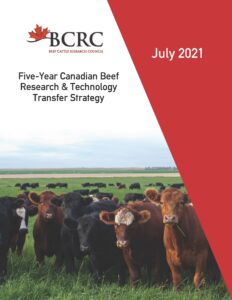Survey Says...?
Remarque : cette page web n’est actuellement disponible qu’en anglais.
This article written by Dr. Reynold Bergen, BCRC Science Director, originally appeared in the August 2021 issue of Canadian Cattlemen magazine and is reprinted on the BCRC Blog with permission of the publisher.
In February’s column I encouraged you to fill out our online beef research survey to help the Beef Cattle Research Council and other industry and government funders develop a clear set of priorities to guide our funding decisions over the next five years. Thanks for responding – we had nearly twice as many responses this time as we got five years ago. The more responses we get, the more confidence we have in the feedback that comes in. Here are some of the highlights of what you told us.
What We Did:
The survey was open between January 5 and March 5, 2021. It asked you to rate a variety of research issues as Extremely, Very, Moderately, Slightly or Not Important in the areas of feed efficiency and utilization, forage and grassland productivity, environmental sustainability, animal health and welfare, beef quality and food safety. We also asked how often producers used different communication channels for production information and how influential they were in their decision making.
A total of 878 Canadians responded to the survey. This article focuses on the responses provided by the 65 seedstock, 497 cow-calf and 33 feedlot producers, as well as the 39 veterinarians (for the animal health and welfare section) and 26 non-governmental organization (NGO) representatives (for the environmental sustainability section). We paid particular attention to issues that were rated as Extremely or Very Important by 75% or more of respondents, as well as issues that were rated as Slightly or Not Important by 25% or more of respondents.
What We Learned:
Feed efficiency and utilization: Cow-calf and seedstock respondents prioritized differences in wintering costs between efficient and inefficient cows, while feedlot operators prioritized the impacts of feed quality and feedlot management practices on feed efficiency. Not surprisingly, feedlot operators rated barley and corn yields more highly than cow-calf or seedstock producers.
Forage and grassland productivity: Forage yield and quality were priorities across both the cow-calf and feedlot sectors. The cow-calf sector also prioritized stand longevity and rejuvenation, grazing management and winter-feeding strategies. Flood resistance was deemed slightly or not important by 28% of respondents, probably because it tends to be a regional concern.
Environmental sustainability: Water use, quality and management was a priority for both the beef industry and NGOs. Nutrient management and soil health and quality were seen as priorities across industry sectors. Curiously, greenhouse gas reduction was rated as less important by seedstock producers than by cow-calf or feedlot respondents.
Animal health and welfare: Reproductive efficiency was a high priority for seedstock, cow-calf producers and veterinarians. All sectors highlighted disease prevention, improved management practices and other tools to reduce the need for antimicrobials. Feedlot operators and veterinarians both prioritized respiratory disease and production-limiting disease surveillance. Veterinarians highlighted the importance of research focusing on improved diagnostics, pain management and lameness. Pinkeye fell into the slightly or not important categories for seedstock producers, cow-calf producers and veterinarians.
Beef Quality priorities rated as “extremely important” or “very important” by beef producers included improved product consistency and quality, benchmarking consumer satisfaction with Canadian beef, comparing the nutritional value of beef with respect to other animal and plant proteins and identifying what differentiates Canadian beef and beef production from international competitors.
Food safety: Verifying the effectiveness of packing equipment cleaning processes was a priority for cattle sector respondents. Feedlot respondents also identified the development of technologies targeting multiple pathogens in cattle and beef production and processing facilities as a high priority.
Technology transfer: Across all sectors of the industry, 73 to 93% of producers use magazines, newspapers and other printed materials to learn about science-based information at least monthly. Veterinarians are consulted monthly by 76 to 82% of producers, followed by websites, blogs and social media (including www.beefresearch.ca) at 55 to 81%.
So, What Does This Mean… to Me?
Research and adoption of improved production practices can help producers reduce production costs, support consumer confidence and improve the public’s perception of beef. There are a lot of different beef research funding agencies across Canada, but not all of them have a strong understanding of producer needs – that’s what this survey provides. The full results of the producer survey can be seen on pages 46-50 of the Five-Year Canadian Beef Research and Technology Transfer Strategy on the BCRC website (www.beefresearch.ca).
These survey results helped target the beef, cattle and forage research outcomes and priorities underpinning the updated Canadian Beef Research and Technology Transfer Strategy. We also held targeted workshops to get input from producers, researchers, extension specialists, government, veterinarians and other industry experts as we developed the Strategy. So, this isn’t just the BCRC’s strategy. We involved this broad range of participants to encourage all of Canada’s research funders to focus on answering questions and solving problems that are relevant to producers across Canada. Your participation in this survey will help the industry groups you fund (like the BCRC and your provincial cattle organization) invest your check-off funds more strategically and effectively and help federal and provincial government funders invest our tax dollars more strategically and effectively as well.
Click here to subscribe to the BCRC Blog and receive email notifications when new content is posted.
The sharing or reprinting of BCRC Blog articles is typically welcome and encouraged, however this article requires permission of the original publisher.
We welcome your questions, comments and suggestions. Contact us directly or generate public discussion by posting your thoughts below.

